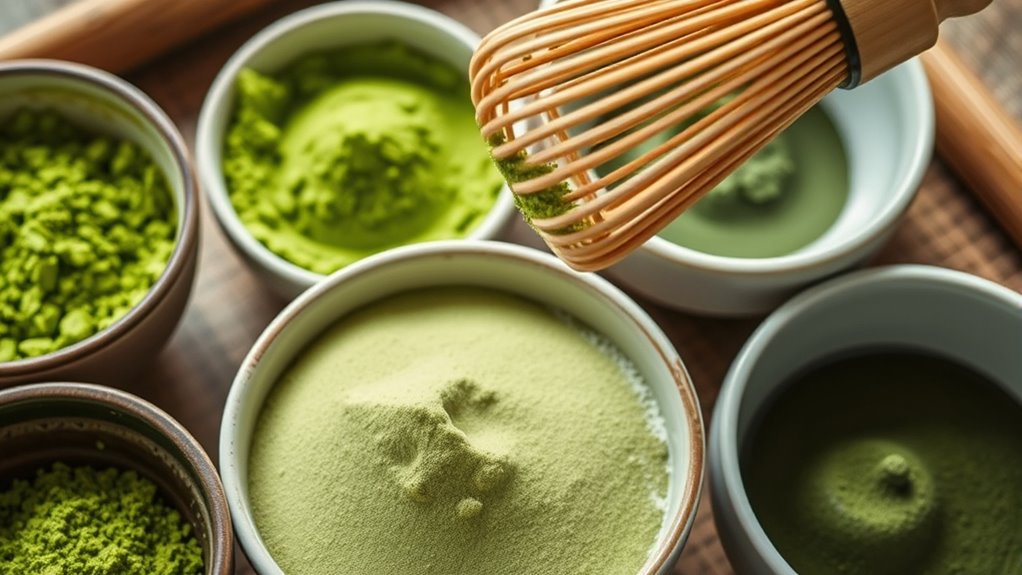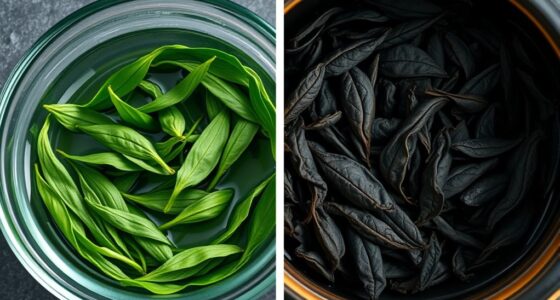Understanding matcha involves knowing its grades, which vary from ceremonial to culinary, affecting flavor and quality. Whisking techniques differ: usucha is prepared with a quick, vigorous whisk for a light froth, while koicha uses less water and requires careful whisking for a thick, umami-rich brew. By mastering these styles and grade distinctions, you’ll enhance your matcha experience and appreciation. Keep exploring, and you’ll discover even more ways to enjoy this vibrant green tea.
Key Takeaways
- Matcha grades range from ceremonial (highest quality) to culinary (more affordable), affecting flavor and intended use.
- Usucha is a lighter, frothy tea prepared with less powder and more water, ideal for daily drinking.
- Koicha is a thick, concentrated tea with more powder and less water, reserved for traditional ceremonies.
- Whisking techniques differ: vigorous whisking creates frothy usucha, while gentle, slow whisking produces smooth koicha.
- Understanding these differences enhances appreciation of matcha’s flavor profiles, preparation methods, and cultural significance.

Have you ever wondered what makes matcha so special? At its core, the secret lies in how it’s cultivated and processed. Tea cultivation for matcha is meticulous, involving shade-growing the tea leaves—specifically the young, tender tencha leaves—about three to four weeks before harvest. This shading process boosts chlorophyll levels, giving the leaves a vibrant green hue, and increases amino acids like L-theanine, which contribute to matcha’s unique flavor and matcha health benefits. Because of this careful cultivation, matcha is packed with antioxidants, catechins, and other nutrients that support your immune system, boost metabolism, and improve mental clarity. These health perks are why many choose matcha over other teas, knowing they’re sipping a beverage that’s not only delicious but also beneficial for their well-being.
Once harvested, the leaves are steamed, dried, and then ground into a fine powder using traditional stone mills. This grinding process is slow and precise to preserve the delicate flavors and nutrients. Unlike other teas, where you steep leaves and discard them, with matcha, you consume the entire leaf. That’s what makes matcha health benefits so potent—you’re ingesting all the concentrated compounds that were cultivated through careful tea cultivation. As a result, each sip delivers a rich dose of antioxidants and amino acids, promoting relaxation and alertness simultaneously.
When preparing matcha, the texture and method matter greatly. For a light, frothy drink, you’ll want to whisk the powder vigorously using a bamboo chasen (whisk) until it’s smooth and frothy—this is called usucha. It’s the more common preparation, ideal for everyday consumption. But if you’re seeking a more intense, bold flavor, you might prepare koicha, which involves using more matcha powder and less water. Koicha is thick, sticky, and requires careful whisking to achieve the right consistency, often enjoyed during traditional tea ceremonies. The difference between usucha and koicha isn’t just about thickness but also about the experience and flavor profile. Usucha offers a lighter, more invigorating taste, while koicha provides a concentrated, umami-rich flavor that can be quite powerful.
Understanding these nuances allows you to appreciate matcha on a deeper level. Whether you prefer a quick, energizing cup or a ceremonial, meditative experience, knowing the intricacies of tea cultivation, preparation methods, and the health benefits helps you make the most out of every sip. Matcha isn’t just a trendy beverage—it’s a centuries-old tradition rooted in meticulous cultivation and craftsmanship, offering both sensory delight and wellness benefits in every cup.
Frequently Asked Questions
How Does Water Temperature Affect Matcha Flavor?
You’ll notice that water temperature considerably affects your matcha flavor. If you use water that’s too hot, around 80°C or higher, it can make the matcha taste bitter and overpowering. Cooler water, around 60-70°C, helps bring out the natural sweetness and umami, creating a smoother, more balanced flavor. So, adjusting water temperature allows you to customize your matcha experience, highlighting its delicate nuances instead of harshness.
Can Matcha Be Used in Cooking or Baking?
Yes, you can definitely use matcha in cooking and baking. Its cooking versatility allows you to add a unique flavor and vibrant color to smoothies, ice creams, cookies, and cakes. When baking, use proper techniques like mixing with a little hot water first to create a smooth paste, then incorporate it into your batter. Just be mindful of temperature, as high heat can diminish its flavor and nutrients.
What Are the Health Benefits of Different Matcha Grades?
Ceremonial matcha offers the highest antioxidants and amino acids, giving you boosted energy and focus, while culinary matcha provides a more affordable option with slightly fewer nutrients, perfect for baking. In a matcha grade comparison, ceremonial grade benefits your health with pure, premium quality, whereas culinary grade is great for cooking without sacrificing too much flavor. Your choice depends on whether you’re drinking or cooking with matcha for health benefits.
How Long Does Matcha Stay Fresh After Opening?
Did you know that properly stored, matcha can stay fresh up to 3-4 months after opening? To maximize its shelf life, keep it in an airtight container away from light, heat, and moisture. Store it in a cool, dark place or even in the fridge if you won’t use it soon. Follow these storage tips to enjoy the vibrant flavor and health benefits of your matcha longer.
Are There Any Specific Storage Methods for Optimal Freshness?
To guarantee optimal freshness, store your matcha in an airtight container away from light, heat, and moisture. Keep it in a cool, dark place like a pantry or cupboard, and avoid refrigeration unless you live in a humid climate. Always reseal the container tightly after each use, and use within a few weeks of opening. Proper matcha storage helps preserve its vibrant flavor and bright green color.
Conclusion
Now that you know the different grades and preparation styles of matcha, you can confidently enjoy this vibrant green tea. Imagine hosting a quiet afternoon with a bowl of rich koicha, savoring its deep flavor, or sharing a light usucha with friends during a casual gathering. Whether you’re whisking for tradition or experimenting with flavors, understanding matcha’s nuances helps you appreciate every sip. Start exploring, and let each bowl deepen your appreciation for this ancient, versatile tea.









